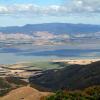Improving researchers' ability to access and analyse climate model data sets
"NeSI has helped us efficiently build a large repository of climate model data from research institutes around the world, which we can now share and analyse in a local supercomputing environment. "
Subject:















